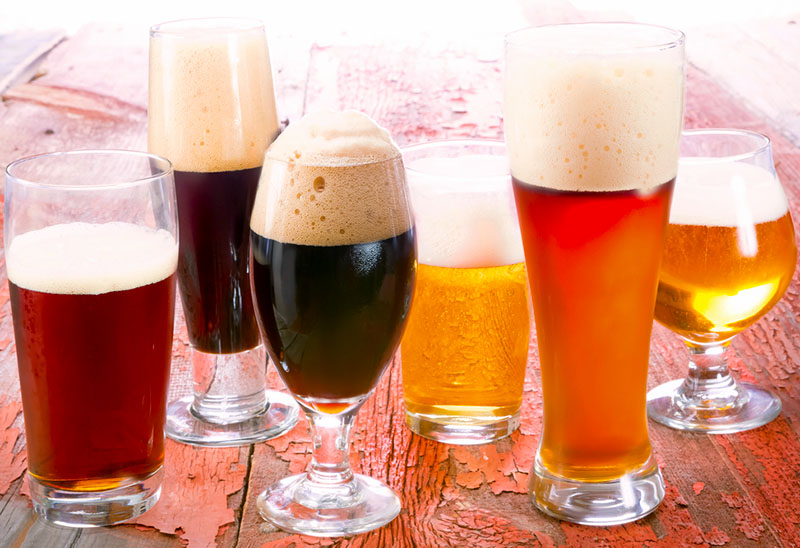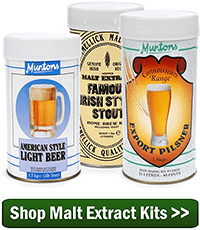 Does it matter which type of beer glass you serve your beer in? Well, often times, no – no one wants to be a snob – but once in a while you want to get the full effect of your brew. This is where the different beer glass types come into play.
Does it matter which type of beer glass you serve your beer in? Well, often times, no – no one wants to be a snob – but once in a while you want to get the full effect of your brew. This is where the different beer glass types come into play.
Proper beer glassware enhances the positive aspects of your homebrew, with different types of beer glasses highlighting different qualities.
Try this: take a very fragrant beer like an IPA or barrel-aged stout and pour some of it into a regular pint glass and some into a tulip or wine glass. Smell the two and compare the aromas – you’ll probably notice a significant difference. This experiment also works with wine and liquor.
So what are some of the different beer glass types and their uses? Below we’ve put together a somewhat comprehensive list of the glasses you’ll run across when drinking your brews. This is a menagerie of glasses that you may want to consider having on hand when serving you your own homebrews.
 Goblet – Ideal for Belgian ales and Berliner weiss, the goblet features a wide mouth for easy access to the beer’s complex flavors and a structure that supports head retention.
Goblet – Ideal for Belgian ales and Berliner weiss, the goblet features a wide mouth for easy access to the beer’s complex flavors and a structure that supports head retention.
 Flute – A flute is a narrow beer glass that tapers towards the bottom. The shape gives the viewer a good look at carbonation and helps release the pleasing aromas of gueze, lambic, swarzbier, and Vienna lager.
Flute – A flute is a narrow beer glass that tapers towards the bottom. The shape gives the viewer a good look at carbonation and helps release the pleasing aromas of gueze, lambic, swarzbier, and Vienna lager.
 Pilsner – The pilsner glass is similar to the flute, but it has a wider mouth. The change in shape showcases color, supports head, and encourages aromatics of – not surprisingly – pilsners, but also blonde ales, bocks, and witbier.
Pilsner – The pilsner glass is similar to the flute, but it has a wider mouth. The change in shape showcases color, supports head, and encourages aromatics of – not surprisingly – pilsners, but also blonde ales, bocks, and witbier.
 Pint Glass – Of all the beer glass types, this is the all-around go-to glass. It is versatile as it is common and is ideal for many of your favorite beers, including amber ale, altbier, English bitter, brown ale, IPA, porter, and pumpkin beer.
Pint Glass – Of all the beer glass types, this is the all-around go-to glass. It is versatile as it is common and is ideal for many of your favorite beers, including amber ale, altbier, English bitter, brown ale, IPA, porter, and pumpkin beer.
 Snifter – The snifter, just like what you would use for brandy or cognac, is a smaller version of a goblet with a lip that turns inward, capturing desirable aromatics. Snifters are smaller than most other glasses, making them a good fit when drinking higher gravity beers. Use a snifter when enjoying barley wine, Belgian dark strong ale, double IPAs, imperial stouts, and tripels.
Snifter – The snifter, just like what you would use for brandy or cognac, is a smaller version of a goblet with a lip that turns inward, capturing desirable aromatics. Snifters are smaller than most other glasses, making them a good fit when drinking higher gravity beers. Use a snifter when enjoying barley wine, Belgian dark strong ale, double IPAs, imperial stouts, and tripels.
 Stange – A stange is a relatively narrow beer glass type with no taper. It concentrates aromas into a narrow channel and gives the drinker a good look at the beer. Stange glasses are appropriate for a number of styles, including altbier, bock, gose, lambic, and rye beer.
Stange – A stange is a relatively narrow beer glass type with no taper. It concentrates aromas into a narrow channel and gives the drinker a good look at the beer. Stange glasses are appropriate for a number of styles, including altbier, bock, gose, lambic, and rye beer.
 Stein – In German, “stein” means stone. For years prior to the widespread use of glass, these large mugs were made of stone. Go to Germany today and ask for a “Mass stein” – they’ll give you a full liter of suds. Steins work great for Oktoberfestbier.
Stein – In German, “stein” means stone. For years prior to the widespread use of glass, these large mugs were made of stone. Go to Germany today and ask for a “Mass stein” – they’ll give you a full liter of suds. Steins work great for Oktoberfestbier.
 Tulip – The tulip is on of the great all-around beer glass types for evaluating your homebrew, regardless of style. The glass’s shape gives a good sense of color, enhances aromas, and holds a big head. The tulip works especially well for saisons and other Belgian styles.
Tulip – The tulip is on of the great all-around beer glass types for evaluating your homebrew, regardless of style. The glass’s shape gives a good sense of color, enhances aromas, and holds a big head. The tulip works especially well for saisons and other Belgian styles.
 Weizen Glass – The weizen glass is designed for wheat beers. Its size allows for a large serving of the refreshing beer and a big, wheaty head while also helping to enhance aromas. Use a Weizen glass for all types of wheat beer.
Weizen Glass – The weizen glass is designed for wheat beers. Its size allows for a large serving of the refreshing beer and a big, wheaty head while also helping to enhance aromas. Use a Weizen glass for all types of wheat beer.
So there you have it, the different beer glass types and their uses! Don’t get too hung up on choosing the appropriate glassware – and definitely don’t shame other people for using the “incorrect” beer glass. The most important thing is to always appreciate the beer!
—–
David Ackley is a beer writer, brewer, and self-described “craft beer crusader.” He holds a General Certificate in Brewing from the Institute of Brewing and Distilling and is founder and editor of the Local Beer Blog.
